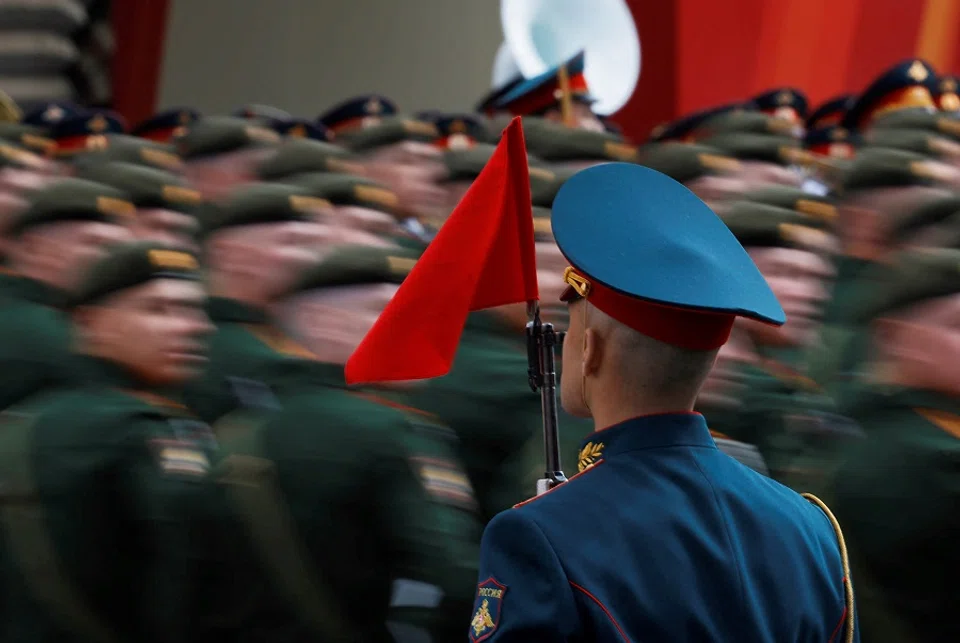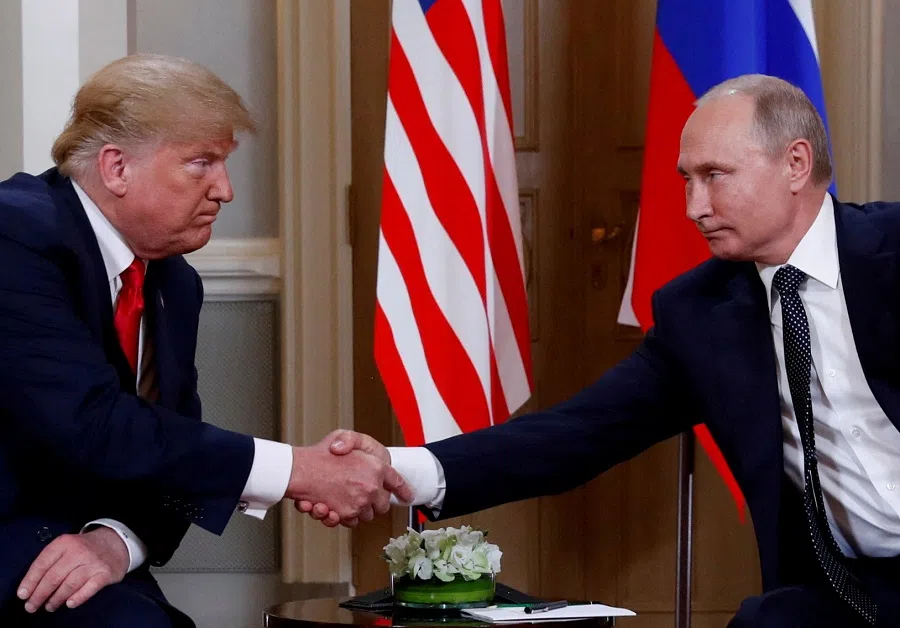The anti-fascist fascist: Why peace with Putin is a dangerous illusion
Though Putin emphatically rejects the label of fascism, his actions — invading Ukraine and annexing Crimea, for instance — certainly say otherwise, argues commentator Jin Jian Guo.

A saying has been making the rounds on Chinese social media: “Churchill said that the fascists of the future will call themselves anti-fascists.” However, people have been unable to find this quote in Churchill’s writings or speeches.
A fascist masquerading as anti-fascist
This might be a phenomenon known as “Churchillian Drift”, where the words and sayings of unknown people are misattributed to Churchill. The true significance of the phrase lies not in whether Churchill actually said it, but in how it reveals the way anti-civilisational dictators manipulate language.
Vladimir Putin’s annual Victory Day showcase in Red Square on 9 May is an instance of such a deceptive performance — a fascist masquerading as anti-fascist.
Modern dictators use language in line with universal values while implementing policies similar to those of fascist regimes. For instance, they manipulate democratic elections and suppress opposition; their constitutions incorporate freedom of speech, yet they crack down harshly on it; they talk of democracy while moving quickly to imprison those who hold opposing political views.
Vladimir Putin’s annual Victory Day showcase in Red Square on 9 May is an instance of such a deceptive performance — a fascist masquerading as anti-fascist. Three years ago, he launched a war against Ukraine, disregarding the UN Charter, committing war crimes and crimes against humanity. In reaction to Putin’s Red Square spectacle and the International Criminal Court’s warrant for his arrest, 35 European nations established a special tribunal to prosecute Russia.
Why Putin does not want peace
Pastor Mark Burns, known as Donald Trump’s “spiritual adviser”, provided strong evidence of Putin’s war crimes. After visiting Ukraine in early May, he made a report to Trump. Burns told the Kyiv Independent about “the atrocities that have taken place, innocent lives being killed, executed, and knowing the nearly 700 religious institutions have been intentionally targeted by the Russians, and 20,000 children have been kidnapped and deported back to Russia”. He stated Putin is “pure evil” and believed that Trump has pressured Putin to express his dissatisfaction.
Burns holds little sway over Trump, whose pressure on Putin is motivated by both a US-Ukraine mineral agreement and Putin’s resistance to a ceasefire. Putin’s unwavering stance stems from the war’s failure to meet his objectives, while Ukraine’s staunch defence complicates his efforts to secure favourable terms in negotiations.
Putin’s aim was to legitimise the annexation of Crimea, and take over eastern Ukraine. This goal is rooted in his persistent imperial ambition as he seeks to restore the former borders of the Russian empire. He lamented the “paralysis of power and will” that led to the “degradation and oblivion” of the Soviet Union in 1991. Putin described the dissolution of the Soviet Union as a tragedy, and draws imperialist inspiration from Russia’s past — a vision that has fuelled a series of foreign wars.

Putin did not anticipate the level of resistance his invasion of Ukraine would provoke. Not only did he face tenacious opposition from Ukraine itself, but he also encountered strong resistance from the majority of European countries.
In the first 100 days of his presidency, Trump attempted to mediate the Russia-Ukraine war from a pro-Putin stance, which proved unsuccessful. He has himself admitted that ending the Russia-Ukraine war is not easy — “maybe it’s not possible”.
From the outset, Putin has been unwilling to compromise, and any change in that posture will depend heavily on developments on the ground and the evolving political dynamics in Europe, Ukraine, and the US. Trump’s Putin-leaning approach has left Ukraine’s supporters feeling dejected.
On 5 May, former US Vice-President Mike Pence said in an interview that “if the last three years teaches us anything, it’s that [Putin] doesn’t want peace; he wants Ukraine.” Pence believed that the US needed to make it clear “to provide Ukraine with the military support they need to repel the Russian invasion and achieve a just and lasting peace.”
On 7 May, former US President Joe Biden told the media that Trump’s demand for Ukraine to give up territory in exchange for peace amounted to “modern-day appeasement.” Biden stated that “I just don’t understand how people think that if we allow a dictator, a thug, to decide he’s going to take significant portions of land that aren’t his, that that’s going to satisfy him.”
The intense repression stems from concerns over regime instability. Putin needs to fabricate victories to legitimise his rule.
The basis of autocratic dictatorship is inherently weak
In his first 100 days, Trump’s approach to the Russia-Ukraine war signalled a troubling tilt: pressure the victim, appease the aggressor. This stance not only forsook justice — it failed to earn any meaningful concession from Putin. The miscalculation stems from a fundamental misunderstanding: dictators rarely compromise when cornered. When their ambitions stall, they double down, constrained by the fervent nationalism they themselves helped inflamed.
Putin’s invasion of Ukraine initially garnered support from the majority of Russians, but three years of war have drained national resources and reduced living standards. Without a decisive victory on the battlefield, Putin’s position could become increasingly precarious.

The basis of autocratic dictatorship is inherently weak, and its edifice of authority can collapse instantly. Putin’s weakness is evident in the severe repression within Russia. According to data from the Russian independent human rights monitoring organisation OVD, as of early May this year, 3,284 people have been charged with political crimes in Russia, with 1,590 currently in prison. The Russian Ministry of Justice has now designated over 900 Russian entities as “foreign agents”, including more than 500 individuals, whose rights are severely restricted. The intense repression stems from concerns over regime instability. Putin needs to fabricate victories to legitimise his rule.
Putin’s denial of Ukraine as a sovereign state and his rhetoric of “de-Nazification” certainly aligns with the saying that fascism is appearing in the guise of anti-fascism.
Calling a spade a spade
Putin’s intransigence and Ukraine’s refusal to surrender ensured that Trump’s pro-Putin mediation was doomed to fail. Trump should now understand that reaching a comprehensive solution acceptable to both sides — one that ensures lasting peace — is almost impossible.
Putin is insistent that any agreement must address the so-called “roots” of the conflict, which he defined very clearly. For him, the core issue is Ukraine’s staunch resistance to Russian control. “Demilitarisation” and “de-Nazification” are not just pet phrases for Putin; they shape his demands for a solution.
Putin’s denial of Ukraine as a sovereign state and his rhetoric of “de-Nazification” certainly aligns with the saying that fascism is appearing in the guise of anti-fascism. Historical experience in defeating fascism has revealed the hard truth of seeking peace through strength.
In 2014, Kissinger proposed the “Finlandisation” model for Ukraine — where Ukraine would be progressively integrated into Europe, but would also maintain close economic relations with Russia and preserve its neutrality by staying outside of NATO — but he later changed his view. Finland’s current president, Alexander Stubb, felt that the term “Finlandisation” was a “national insult”. He also stated that Finland sacrificed its values but did not sacrifice its independence.
Former Latvian defence minister Artis Pabriks told Ukraine “you will be slaughtered, so don’t give up. It’s better to die on the front lines than to be executed afterward.” History tells the countries surrounding Russia that Russia never keeps its promises, and reform will only occur when it is defeated.
This article was first published in Lianhe Zaobao as “法西斯正以反法西斯面目出现”.





